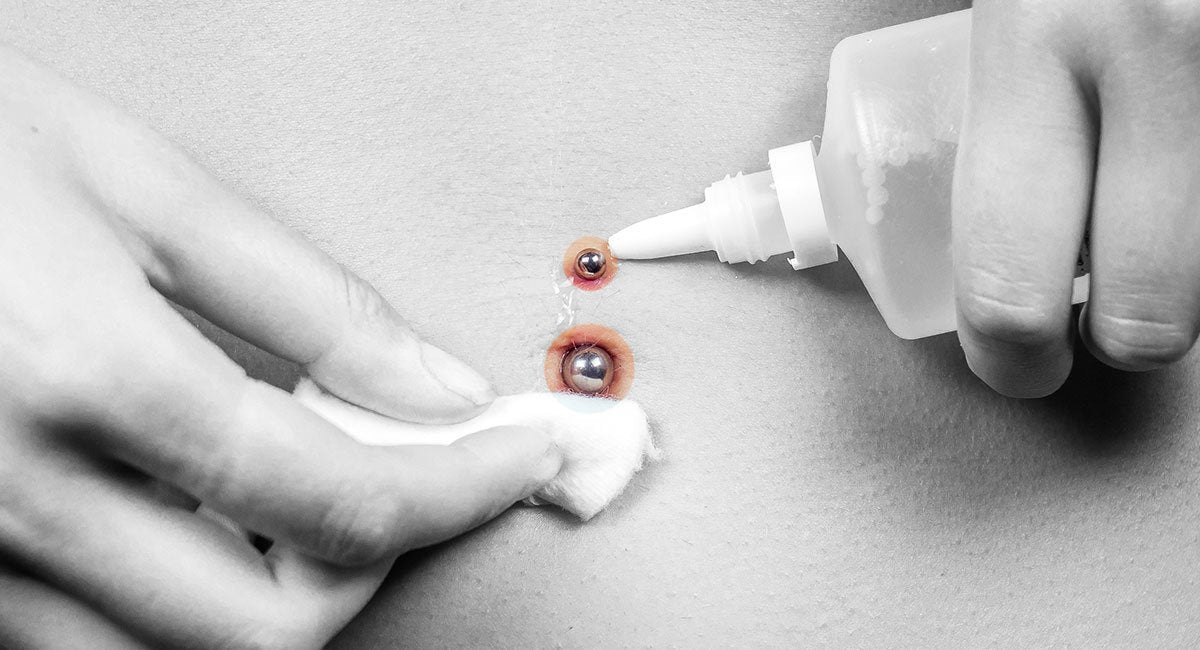Suggested Aftercare for Body Piercings

Cleaning Care
Cleaning Solutions
- Packaged sterile saline (with no additives, read the label) is a gentle choice for piercing aftercare. If sterile saline is not available in your region a sea salt solution mixture can be a viable alternative. Dissolve 1/8 to 1/4 teaspoon (.75 to 1.42 grams) of non-iodized (iodine-free) sea salt into one cup (8 oz / 250 ml) of warm distilled or bottled water. A stronger mixture is not better; a saline solution that is too strong can irritate the piercing.


Cleaning Instructions for Body Piercings
- WASH your hands thoroughly prior to cleaning or touching your piercing for any reason.
- SALINE rinse as needed during healing. For certain placements it may be easier to apply using clean gauze saturated with saline solution. A brief rinse afterward will remove any residue.
- If your piercer suggests using soap, gently lather around the piercing and rinse as needed. Avoid using harsh soaps, or soaps with dyes, fragrances, or triclosan.
- RINSE thoroughly to remove all traces of the soap from the piercing. It is not necessary to rotate the jewelry through the piercing.
- DRY by gently patting with clean, disposable paper products because cloth towels can harbor bacteria and snag on jewelry, causing injury.
General Aftercare
What is Normal?
- Initially: some bleeding, localized swelling, tenderness, or bruising.
- During healing: some discoloration, itching, secretion of a whitish-yellow fluid (not pus) that will form some crust on the jewelry. The tissue may tighten around the jewelry as it heals.
- Once healed: the jewelry may not move freely in the piercing; do not force it. If you fail to include cleaning your piercing as part of your daily hygiene routine, normal but smelly bodily secretions may accumulate.
- A piercing may seem healed before the healing process is complete. This is because tissue heals from the outside in, and although it feels fine, the interior remains fragile. Be patient, and keep cleaning throughout the entire healing period.
- Even healed piercings can shrink or close in minutes after having been there for years! This varies from person to person; if you like your piercing, keep jewelry in—do not leave it empty.
- Wash your hands prior to touching the piercing; leave it alone except when cleaning. During healing, it is not necessary to rotate your jewelry.
- Stay healthy; the healthier your lifestyle, the easier it will be for your piercing to heal. Get enough sleep and eat a nutritious diet. Exercise during healing is fine; listen to your body.
- Make sure your bedding is washed and changed regularly. Wear clean, comfortable, breathable clothing that protects your piercing while you are sleeping.
- Showers tend to be safer than taking baths, as bathtubs can harbor bacteria. If you bathe in a tub, clean it well before each use and rinse off your piercing when you get out.
- Avoid moving jewelry in an unhealed piercing, or picking away dried discharge with your fingers.
- Avoid cleaning with Betadine®, Hibiciens®, alcohol, hydrogen peroxide, Dial® or other soaps containing triclosan, as these can damage cells.
- Avoid ointments as they prevent necessary air circulation.
- Avoid Bactine®, pierced ear care solutions and other products containing Benzalkonium Chloride (BZK). These can be irritating and are not intended for long term wound care.
- Avoid over-cleaning. This can delay your healing and irritate your piercing.
- Avoid undue trauma such as friction from clothing, excessive motion of the area, playing with the jewelry, and vigorous cleaning. These activities can cause the formation of unsightly and uncomfortable scar tissue, migration, prolonged healing, and other complications.
- Avoid all oral contact, rough play, and contact with others' bodily fluids on or near your piercing during healing.
- Avoid stress and recreational drug use, including excessive caffeine, nicotine, and alcohol.
- Avoid submerging the piercing in unhygenic bodies of water such as lakes, pools, hot tubs, etc. Or, protect your piercing using a waterproof wound-sealant bandage. These are available at most drugstores.
- Avoid all beauty and personal care products on or around the piercing including cosmetics, lotions, and sprays, etc.
- Don't hang charms or any object from your jewelry until the piercing is fully healed.
Hints and Tips for Particular Areas
Jewelry
- Unless there is a problem with the size, style, or material of the initial jewelry, leave it in the place for the entire healing period. See a qualified piercer to perform any jewelry change that becomes necessary during healing. See the APP website to locate an APP member, or to request a copy of our Picking Your Piercer brochure.)
- Contact your piercer if your jewelry must be removed (such as for a medical procedure). There are non-metallic jewelry alternatives available.
- Leave jewelry in at all times. Even old or well-healed piercing can shrink or close in minutes even after having been there for years. If removed, re-insertion can be difficult or impossible.
- With clean hands or paper product, be sure to regularly check threaded ends on your jewelry for tightness. ("Righty-tighty, lefty-loosey.")
- Should you decide you no longer want the piercing, simply remove the jewelry (or have a professional piercer remove it) and continue cleaning the piercing until the hole closes. In most cases only a small mark will remain.
- In the event an infection is suspected, quality jewelry or an inert alternative should be left in place to allow for drainage of the infection. If the jewelry is removed, the surface cells can close up, which can seal the infection inside the piercing channel and result in an abscess. Do not remove jewelry unless instructed to by a medical professional.
Navel:
- A hard, vented eye patch (sold at pharmacies) can be applied under tight clothing (such as nylon stockings) or secured using a length of Ace® bandage around the body (to avoid irritation from adhesive). This can protect the area from restrictive clothing, excess irritation, and impact during physical activities such as contact sports.
- Use the t-shirt trick: Dress your pillow in a large, clean t-shirt and turn it nightly; one clean t-shirt provides four clean surfaces for sleeping.
- Maintain cleanliness of telephones, headphones, eyeglasses, helmets, hats, and anything that contacts the pierced area.
- Use caution when styling your hair and advise your stylist of a new or healing piercing.
- The support of a tight cotton shirt or sports bra may provide protection and feel comfortable, especially for sleeping.
- Genital Piercings—especially Prince Alberts, Ampallangs, and Apadravyas—can bleed freely for the first few days. Be prepared.
- Urinate after using soap to clean any piercing that is near the urethra.
- Wash your hands before touching on (or near) a healing piercing.
- In most cases you can engage in sexual activity as soon as you feel ready, but maintaining hygiene and avoiding trauma are vital; all sexual activities should be gentle during the healing period.
- Use barriers such as condoms, dental dams, and waterproof bandages, etc. to avoid contact with your partners' body fluids, even in monogamous relationships.
- Use clean, disposable barriers on sex toys.
- Use a new container of water-based lubricant; do not use saliva.
- After sex, an additional saline soak or clean water rinse is suggested.
Each body is unique and healing times vary considerably. If you have any questions, please contact us.
---
Content compiled by:
*Disclaimer: These guidelines are based on a combination of vast professional experience, common sense, research, and extensive clinical practice. This is not to be considered a substitute for medical advice from a doctor. If you suspect an infection, seek medical attention. Be aware that many doctors have not received specific training regarding piercing. Your local piercer may be able to refer you to a piercing-friendly medical professional. For more information, see the APP Brochure.
This information from the APP brochure is licensed under the Creative Commons Attribution-Noncommercial-No Derivative Works License. To view a copy of this license, visit http://creativecommons.org/licenses/by-nc-nd/3.0/.
 is here! Shop now, pay later in 4 easy installments
is here! Shop now, pay later in 4 easy installments



